Mark Sisson's Blog, page 192
February 16, 2017
What Is the Vagus Nerve? (and How Does It Impact Health, Mood and Performance?)
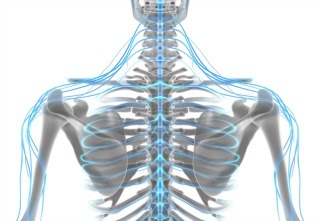 In recent years, I’ve regularly vouched for the gut as our long-abused secondary brain. Given what most of us grew up learning in school, it can feel like a mammoth shift. Science and philosophy have long revered the brain as seat of consciousness, even the seat of humanity itself. But when it comes down to it, everything is interconnected. Our consciousness extends well beyond the brain. How we feel and who we are encompasses a much more expansive and intricate system than any of us learned in high school biology. At the center of this paradigm revision is something called the vagus nerve.
In recent years, I’ve regularly vouched for the gut as our long-abused secondary brain. Given what most of us grew up learning in school, it can feel like a mammoth shift. Science and philosophy have long revered the brain as seat of consciousness, even the seat of humanity itself. But when it comes down to it, everything is interconnected. Our consciousness extends well beyond the brain. How we feel and who we are encompasses a much more expansive and intricate system than any of us learned in high school biology. At the center of this paradigm revision is something called the vagus nerve.
Vagus…as a word it sounds a little off-putting. If someone called me a vagus, I’d probably be mildly offended. But the literary origins of this word are actually kind of mystical: “vagus” in Latin translates to “wandering.” And I’d struggle to find a more apt definition.
The vagus nerve runs from the base of the brain, through the neck, and into the chest and stomach, reaching all the way to the gut. It’s regularly likened to a highway, whereby vast multitudes of nerves are constantly “driving” to almost every organ in the body, delivering vital messages and returning to the brain with their own little snippets of info. Around 80% of these nerve fibers are directed outwards from the brain, while the remaining 20% or so work in reverse to send commands back to the brain from the various corners of the body.
Unsurprisingly, the role of this wandering nerve highway is far-reaching. Regulation of breathing. Control of digestion and satiety. Taste response. Hearing. Vocalization. Relaxation response. Even blood circulation. It’s the quiet overachiever of your parasympathetic nervous system.
And it’s stirring some rather fascinating conversations within the medical community (conventional and otherwise).
Vagus Influence over Satiety
Feeling hungry or full? It’s that mysterious vagus nerve at work. During a meal, the volume of food in the stomach stimulates the vagus nerve to message your call center operator (brain), which then flips the switch that says “full.” Seems pretty straightforward.
Further down, in the depths of your gastrointestinal tract, the vagus is also operating. As I discussed in this post, the gut contains a range of receptors that recognize whether you’ve received enough of certain nutrients. These include serotonin, ghrelin, and gustducin (aka glucose) receptors. The food you eat may or may not fire up these receptors, depending on whether it contains those nutrients. And the means by which your brain receives the nutrient satiety all-clear? Why, none other than the vagus. This is the quality to your stomach’s bulk-food quantity sensors.
So, the vagus and your stomach: an unlikely romance. But where things can turn sour are with regards to a compromised vagus nerve. When the vagus is underperforming, those all-important satiety signals from both the stomach and the intestines don’t always make their way back to the brain. You choose the metaphor: nerve traffic jams, road work, giant nerve-eating potholes…that kind of thing.
For this reason, when the vagus is performing at less than 100 percent, you’re more likely to overeat or get insatiable cravings for the wrong kinds of foods. A classic example of this is those glucose taste receptors in your gut I talked about earlier. Vagus dysfunction can prevent those receptors from signaling to the brain that sufficient sugars and carbs have been consumed, essentially leading to a glucose overdose and impaired insulin secretion.
We all know where this is going: obesity. But vagus nerve dysfunction is by no means limited to battles with excessive weight gain.
The Vagus-Inflammation Connection
As a key component of your parasympathetic nervous system, the vagus is a nerve associated with times of plenty rather than hardship or trauma. In other words, it’s more of a “rest and digest” kind of guy rather than a mechanism of “fight or flight.”
For this reason, stimulating the vagus nerve is associated with an anti-inflammatory response in the brain. By activating, the vagus is telling the brain that all is well with the world, and to ease off on stress response and the production of inflammatory cytokines. The science behind it is somewhat mind-exploding, but here’s my layman’s summary.
Some sort of external catalyst triggers an immune response in the body. Example: gluten. In this scenario, your gut issues a plea for help via the vagus. Vagus communicates SOS to immune cells via the brain, which then release “pro-inflammatory cytokines” to give the invader in your gut (gluten) a good walloping. Walloping complete, the efferent (aka outgoing) part of the vagus regulates this immune activation and suppresses the inflammatory cytokines. Inflammation over and out.
As you can guess, the health of the vagus nerve may have a lot to tell us about autoimmune function/dysfunction—as well as a host of other physical conditions.
The Advent of Vagus Nerve Stimulation
Researchers have caught on to that notion in recent years. Vagus nerve stimulation (VNS) first appeared on medical shelves in 1997, designed to provide a viable alternative to anti-seizure drugs. A small device is surgically implanted into a patient’s chest in order to emit electrical pulses into the vagus nerve for 30 seconds every five minutes. Of those epileptics who receive VNS, apparently half of them see a 50 percent drop in seizures. Kind of a Matrix-esque therapy that undoubtedly feels like a miracle to those who live with frequent seizures.
From there, medical curiosity regarding the vagus nerve intensified considerably. Those patients receiving VNS for their epilepsy started to report improved mood and less propensity for depression. That would likely be the serotonin receptors in their gut finally getting through to the brain via an electrically-boosted vagus. The logical next step was to begin using VNS for treatment of chronic depression, which was approved by our friends at the FDA in 2005. The results of this treatment have been mixed, with certain patients responding well and others showing no improvements. Unfortunately, 55 percent of patients also appear to exhibit “voice alteration and hoarseness” as a side effect.
But the vagus correlations didn’t stop there. Depressed patients also reported a notable reduction in appetite while undergoing the VNS treatment. And so VNS for obesity treatment was born, with a significant degree of success.
You see where this is going: scientists continue to discover more about the vagus nerve and how it controls a wide array of vital functions in the body. Mark S. George, director of the brain stimulation lab at the Medical University of South Carolina, notes that “[VNS] affects our brain circuitry in a profoundly powerful way…Not only can you select which fibers you want to target with VNS, you can also control which way you want the information to go and your effect.”
In the next several years, it will be interesting to follow the application of VNS and its progress in the fields of Crohn’s disease, rheumatoid arthritis, asthma, tinnitus, and even stroke recovery. Results are looking promising.
The Vagus and a Primal Lifestyle (or What’s in It for Us?)
Of course, most of this is just conventional, symptom-centric medical stabs in the dark. The research on the vagus nerve is still relatively new, but we’re learning.
That leads us to the question of the day: what does it have to do with me, with you, with the general population? What does the “wandering” nerve have to offer us?
For starters, it’s apparent from early research that the vagus nerve can be damaged by a poor diet. Lab tests, while small, have drawn links between diabetes and vagal degeneration, the cause of which we know to be a chronic glucose and fructose overload. Diabetic damage to the vagus nerve can lead to a condition called gastroparesis, in which the muscles of the stomach and intestines are unable to effectively move food through the GI tract. Other research suggests that alcohol abuse can also lead to vagal damage, due to the toxic influence alcohol has on the autonomic nervous system, of which the vagus is a part.
All right, so you need to avoid sugar, eat a balanced diet, and minimize alcohol consumption. Check, check and check. Even a casual Primal type shouldn’t have too much difficulty on those fronts. But beyond simply avoiding vagal damage, how can you supercharge your vagus? Surely, improving the health of the vagal nerve must have benefits?
Yes, indeed. A Swiss study a couple of years back found that healthy vagus communication between your gut and brain helps you to slow down and unwind after a stressful situation. Lab tests showed that the vagus nerve releases neurotransmitters following a traumatic event to lower heart rate, lower blood pressure, and enable your organs to take it easy after genuinely distressing or simply trying events. The take-away here is that supporting a healthy vagus increases your ability to live resiliently, deal with stress, and recover faster. That’s a very valuable thing indeed.
And rest assured there’s likely no need for a lab assistant to zap you either. A study from early last year used a new non-invasive vagus nerve stimulator to reduce symptoms of major depressive disorder. Other studies have shown significant stress reduction and increased feelings of happiness by temporarily stimulating the vagus nerve. There’s ample reason to believe that these benefits can also be achieved by practicing mindfulness meditation (or your version thereof).
Finally, supporting a healthy vagus can help you to improve performance under pressure. Endurance athlete and coach Christopher Bergland, who has written at length on the vagus, offers some perspective on supporting and improving the vagal functioning: “healthy vagal tone is indicated by a slight increase of heart rate when you inhale, and a decrease of heart rate when you exhale. Deep diaphragmatic breathing—with a long, slow exhale—is key to stimulating the vagus nerve and slowing heart rate and blood pressure, especially in times of performance anxiety. A higher vagal tone index is linked to physical and psychological well-being. A low vagal tone index is linked to inflammation, negative moods, loneliness, and heart attacks.”
So how do you get your hands on some of this healthy vagal tone action when the going gets tough? Bergland has a few mostly anecdotal answers:
Visualize the vagus nerve, and even consider talking to it (non-verbally, that is!). Picture the very part of the body that is physiologically designed to relax you. The literal representation doesn’t matter so much as the intent.
Get plenty of exercise on a daily basis. Physical activity, including cardiovascular training, strength training and even yoga can all stimulate vagal tone and harmonize relevant hormonal output.
Consciously generate positive thoughts and optimism. The positive feedback loop keeps you emotionally elevated.
Admittedly, there’s plenty for research to fill in in the coming years. That being said, a few other studies on the vagus nerve appear to confirm the application of Primal living for vagal tone. This study, for instance, found that rats fed a high-fat diet experienced a significant lowering of inflammatory response by way of the vagus nerve. A more recent study showed that a certain probiotic strain of Lactobacillus activated the vagus nerve and halted the release of cortisol during a stressful situation. And of course there’s always slow, controlled breathing.
Not too hard or revolutionary for the Primal mind. Incidentally, actions that support neuroplasticity may by extension support vagal health as well.
Thanks for reading, everyone. Have you read/heard much about the vagus nerve? How do you think of this addition to the brain-gut axis picture? Take care.

The post What Is the Vagus Nerve? (and How Does It Impact Health, Mood and Performance?) appeared first on Mark's Daily Apple.



February 15, 2017
8 Alternative Therapies Worth Considering
 Here at Mark’s Daily Apple, I avoid writing off anything without first investigating it. I keep one foot in the “alternative” health world and one in the “conventional” realm, making sure to maintain a skeptical—but openminded—stance on everything. There’s no other way to do it, if you’re honest. At least as far as I can tell.
Here at Mark’s Daily Apple, I avoid writing off anything without first investigating it. I keep one foot in the “alternative” health world and one in the “conventional” realm, making sure to maintain a skeptical—but openminded—stance on everything. There’s no other way to do it, if you’re honest. At least as far as I can tell.
No, not every alternative therapy works. A lot of it is pure hogwash. But whether we’re talking about off-label uses of conventional drugs and illegal drugs, natural pharmacological agents, or downright outlandish-sounding interventions, some therapies are worth considering. Not trying, necessarily. Considering.
Without further ado, let’s take a look at some of them:
Curcumin for Depression
The standard treatment for serious depression is the antidepressant. For years, researchers have been trotting out studies which pit curcumin—the primary phytonutrient in the spice turmeric—against conventional antidepressants or placebos.
In 2014, curcumin improved symptoms in patients with major depressive disorder, showing particular efficacy in people with atypical depression.
In 2015, researchers discovered that curcumin raised levels of certain biomarkers with proven antidepressant effects.
Also in 2015, researchers found that curcumin made antidepressants more effective.
And this year, researchers again confirmed the benefits of curcumin in major depression.
Exercise for Depression
To their credit, doctors are quick to recommend exercise for the treatment of “physical” ailments like osteoporosis, obesity, diabetes, heart disease, arthritis, sarcopenia. It works, and it’s obvious and broadly accepted that it works. But evidence is emerging that exercise can also be an effective primary therapy for depression.
It’s especially good for people who don’t respond to SSRIs. In one study, 30% of folks whose depression did not respond to antidepressants experienced complete remission using exercise. In another, exercise improved self-rated sleep quality in depressed patients.
Psychedelics for Depression, Addiction, and Anxiety
Turn on, tune in, drop out… of your addiction, intractable depression, and crippling anxiety? Maybe.
In patients with terminal cancer, a single dose of psilocbyin (compound in “magic mushrooms”) abolished depression and anxiety. That’s “end of life” anxiety and depression, by the way—the realest stuff around. Other studies have similar results.
Ketamine is a powerful sedative that in smaller doses produces psychedelic effects. More recently, it’s emerged as a rapid antidepressant, with single doses abolishing drug-resistant depression within 24 hours and lasting up to three weeks.
Ibogaine is an African psychedelic whose characteristics make it untenable for recreation but promising for addiction therapy. It’s been used to produce remission of severe opioid addiction. It’s effective against alcoholism and nicotine addiction, and it shows promise against methamphetamine addiction.
It goes without saying that these are all powerful substances that also happen to be illegal in most places. Exercise caution. Several ibogaine clinics are doing good work in Mexico, so that’s an option.
Red Light for Joint Pain, Macular Degeneration, Thyroiditis, Cellulite, and Hair Loss
Shining infrared light on your bum knee and expecting anything to happen sounds ridiculous, right? Well…
Patients with knee osteoarthritis used red light therapy to reduce pain scores and increase microcirculation in the knee. That could mean actual healing.
Literature reviews have concluded that red light therapy does reduce joint pain. even in chronic joint disorders.
Red light exposure increases blood flow to the skin and improves fracture healing.
It’s even been shown to improve neuropathic pain. No “physical” damage necessary.
There are other effects, too.
Applying red light to the eyes of seniors with macular degeneration significantly improved visual acuity after just two weeks. The benefits lasted for at least three years. Yes, years.
Applying red light to the skin covering the thyroid gland in patients with autoimmune thyroiditis for ten sessions improved thyroid function. Placebo did not.
A red light-enhanced comb appears to stimulate hair growth in both men and women with hair loss.
Red light may even help smooth out cellulite, though the jury is still out.
Fecal Transplants for Antibiotic-Resistant C. diff Infections
A friend of mine’s father passed from cancer a decade back. While the cancer ultimately did him in, one of the severest blows occurred when he picked up a nasty case of antibiotic-resistant C. diff in the hospital on a routine check with the oncologist. He was stuck there for weeks. Nothing worked. There’s no question he lost several months or years from dealing with the ramifications of constant watery diarrhea and poor sleep (from being woken up by his rumbling stomach).
I wish I knew about fecal transplants back then, because they are the single most effective (and in many cases, only) way to treat drug-resistant C. diff infections.
Helminths
Modern sterility, medicine, and hygiene have eliminated helminths, yet our immune systems, which evolved in the presence of these parasites, expect them. There’s good evidence that our immune systems are “overactive” without a parasite load to attack, and this has given rise to the increase in asthma, allergies, intestinal diseases, celiac, and even multiple sclerosis.
Helminthic therapy—literally giving yourself worms—sounds gross, but it really does seem to help people deal with some of these conditions.
Forest Bathing for Stress, Diabetes, Hypertension, and Immune Health
Strolling along a wooded path sure is pleasant, but evidence out of Japan—where forest walks known as “forest bathing” are a cornerstone of modern medicine—shows that it can treat disease and ill health. It lowers stress and reduces cortisol, improves blood glucose control (compared to the same amount of walking in a city setting), reduces blood pressure, and increases the activity of cancer-fighting natural killer cells. What’s best of all? Many of these effects last for weeks after a single visit.
But don’t just go once a month. Go as often as possible. Get your green space (even if you’re not sick).
Low-Dose Naltrexone for Seemingly Everything
At normal doses, naltrexone blocks opioid receptors, inhibits GABA activity, and prevents dopamine release, making it great for alcohol or opioid addiction. At low doses, naltrexone blocks opioid receptors just enough to provoke the release of our natural opioids, the endorphins, which helps balance out the immune response and reduce inflammation. A growing number of clinicians are now using low-dose naltrexone as an off-label drug to treat conditions like multiple sclerosis, fibromyalgia, Crohn’s disease, autism, chronic pain, and cancer.
As the immune system and inflammation both play major roles in seemingly every health condition, low-dose naltrexone is also being explored by clinicians in many other fields, including fertility and autoimmune diseases.
That’s it for today, folks. I’d love to hear from you.
What alternative therapies are you curious about? Which ones have you used? Are there any you’d like me to explore further?
Thanks for reading!
The post 8 Alternative Therapies Worth Considering appeared first on Mark's Daily Apple.



February 14, 2017
A Primal Look at Gestational Diabetes
 Every pregnant woman I’ve ever known has hated the oral glucose tolerance test. Yet, they still do it. Drinking a tall glass of sickly sweet orange-flavored glucose water on an empty stomach is thoroughly disgusting, but it, apparently, offers a rare and valuable glimpse into the state of a woman’s perinatal health.
Every pregnant woman I’ve ever known has hated the oral glucose tolerance test. Yet, they still do it. Drinking a tall glass of sickly sweet orange-flavored glucose water on an empty stomach is thoroughly disgusting, but it, apparently, offers a rare and valuable glimpse into the state of a woman’s perinatal health.
What they’re testing for is gestational diabetes mellitus—a variant of diabetes characterized by pancreatic insufficiency during pregnancy.
Sometimes it’s a misdiagnosis. Low-carb, high-fat diets transiently increase insulin resistance. This isn’t a flaw, it’s a feature to ensure you keep burning fat in the tissues that can and preserve precious glucose for the sections of the brain that must burn glucose. But this also means that taking a gestational diabetes test while low-carb can give a false diagnosis.
Moreover, pregnancy in general throws glucose tolerance out of whack. Just like a low-carb diet can induce insulin resistance to temporarily preserve glucose for the brain, pregnancy induces insulin resistance to preserve glucose for the fetus. This made sense when glucose was rarer, when you had to shimmy up a tree for honey or dig for roots and tubers. In that metabolic milieu, a little insulin resistance during pregnancy was adaptive. In today’s environment, where at any given moment you’ve got a million inexpensive glucose calories within a 5-minute drive, it can cause problems.
In babies:
Excessive birth weight.
Injuries from a rough birth.
Low nutrient levels upon entry.
Pre-term delivery.
In moms:
Increased type 2 diabetes risk.
Increased C-section risk.
Increased risk of hypertension and pre-eclampsia.
increased risk of miscarriage.
You have two options to test for it. Well, three technically: you could just skip the test, but I don’t recommend that because GD is quite serious.
Eat 150-250 grams of carbs per day in the week leading up to the test. This will give you a chance to shift back into sugar-burning mode.
Ask for a “whole food” GD test. A friend of mine’s wife opted for a mixed meal containing carbs, fat, and protein instead of drinking the disgusting glucose solution, as a meal is a far more realistic test of one’s ability to tolerate glucose. The most common GD test meal involves pancakes, but those can always be gluten-free.
Okay, say you’ve got gestational diabetes, or you’re worried about getting it. What now?
Prevention
Stopping it before it happens is always the ideal course of action. How can women reduce the risk of gestational diabetes?
Let’s look at risk factors. Beyond “being pregnant,” what else seems to predispose a woman to developing gestational diabetes?
Prior diabetes. Being diabetic makes you more likely to stay diabetic. Same goes for family history of diabetes.
Excess weight. This is another reason pregnancy sets the stage for diabetes: the unavoidable weight gain.
Twins. Carrying twins increases the risk.
Age. Older moms are at a higher risk of GD.
Those are difficult—maybe impossible—risk factors to change, but at least you know your risk profile. Now what can you actually do to reduce the risk?
Be Primal.
You knew it was coming, but this really does work. Eat well, sleep lots, reduce unnecessary stress, get your veggies, eat seafood, and lead a generally healthy lifestyle.
Exercise.
One study found that moderate intensity cycling for 30 minutes 3 times a week in the first trimester drastically reduced the incidence of GD in overweight and obese women.
Although we don’t have data on the relationship between gestational diabetes risk and lifting heavy things, sprinting, burpees, CrossFit, bodyweight training, gymnastics, MovNat, or high-intensity gardening, all those activities improve insulin sensitivity and glucose tolerance.
Eat well and exercise.
A recent study found that healthy eating and exercising are more protective against GD than either alone. No word on what “healthy eating” actually meant. It was probably better than McDonald’s and Doritos, worse than grass-fed meat and sweet potatoes.
Take probiotics, eat fermented food.
One study found that taking probiotics early on in pregnancy reduced the risk of gestational diabetes and slightly reduced birthweight without increasing preterm labor, though it had no effect on miscarriage or fetal death risk.
If you want a food source of some of these strains, most kefirs I’ve encountered in the market have L. rhamnosus GG.
Take myo-inositol.
Pregnant women with a family history of GD who took 2 grams of myo-inositol and 200 mg folic acid each day starting from the end of the first trimester went on to develop less gestational diabetes than the control group who took only folic acid (6% versus 15.3%).
Managing GD
Say you’ve got it. What can you do?
Keep eating well.
Studies on low-carb diets in women with gestational diabetes have had fairly disappointing results. Heck, pretty much all studies of dietary interventions for gestational diabetes have been underwhelming. What might work is a focus on less refined carbs rather than a big reduction in overall carbs. I’ve said before that pregnant women need more carbs than their non-pregnant counterparts. Just make sure they’re unrefined, rather than refined. Anywhere in the range of 120-200g per day is probably best.
Check out this account from a woman who conquered her GD by following the Primal Blueprint. Simple changes like ditching wheat, eating sweet potatoes instead of rice, and eating more veggies—alongside regular checkups with her doctor—did the trick.
But don’t “diet.”
You can change how you eat. In fact, you probably should.
You can eat healthier. Again, you’re better off doing this.
But you shouldn’t diet to lose weight. You shouldn’t cut calories, adopt any extreme eating strategies, adhere to a compressed eating window, or obsess over your weight gain while pregnant.
Focus on improving insulin sensitivity.
Unchecked insulin resistance lies at the heart of gestational diabetes. Pregnancy itself increases IR, so you’re starting from behind. The best thing you can do is review the list of 25 ways to improve insulin sensitivity and make sure you’re doing some of them.
Not all are suitable, though. Pregnant women do have some limitations:
Don’t go too hard or too heavy. Lift weights, safely and moderately. Don’t try to keep up with everyone at CrossFit. Don’t go for any powerlifting PRs, either. Keep things moderately intense across moderate levels of volume. Somewhere in the 5-8 rep range if weighted. Consider just doing bodyweight training, too.
Don’t sprint. While it’s a great way to increase insulin sensitivity, carrying an entire human in your womb makes sprinting unwise.
Keep intensity moderate. Moderate intensity aerobic exercise (30 min/day, 3x/week) really does reduce adverse GD-related outcomes.
Don’t fast. Now is not the time.
Snack on exercise.
If it’s at all possible, weave movement and exercise into your day. Go for walks after meals. Do a few sets of squats before you eat. This will keep your glucose tolerance primed.
Supplements and specific foods may help.
A number of studies show that certain supplements can be useful.
Myo-inositol reduces insulin resistance in women with gestational diabetes.
When given to pregnant women with GD, magnesium improves insulin resistance, glucose tolerance, and other metabolic markers while reducing infant hospitalization and newborn jaundice.
Vitamin D improves insulin sensitivity, blood glucose, and blood lipids in women with GD.
Selenium also improves glucose metabolism while reducing oxidative stress and inflammation in women with GD.
Zinc doesn’t affect birth outcomes in GD, but it does improve inflammatory markers.
Other supplements or supplemental foods that help with insulin sensitivity (haven’t been studied in gestational diabetes), but probably don’t hurt include vitamin K2, cinnamon, ginger, garlic, turmeric (don’t forget the black pepper).
Definitely check with your doctor before beginning any supplementation during pregnancy.
Probiotics and/or fermented food can help.
A recent RCT out of Tehran found that women with GD who took probiotics (strains: Lactobacillus acidophilus LA-5, Bifidobacterium BB-12, Streptococcus thermophilus STY-31 and Lactobacillus delbrueckii bulgaricus LBY-27) once a day for 8 weeks improved fasting glucose, reduced insulin resistance, and gained less weight than the control group.
All of these strains can be commonly found in commercial yogurt and kefir. Check the label for a list of strains.
What about pharmaceuticals?
For many years, the primary pharmaceutical treatment for women with gestational diabetes who weren’t responding to diet and exercise was an insulin injection. More recently, some doctors are giving metformin, whose potential life extension applications I’ve discussed before, to GD patients. Neither seem to be any worse for the mom or baby than the other. Another anti-diabetic drug sometimes given to women with GD called glyburide seems to increase the risk of complications.
Sadly, as of this year, we still don’t have any good research comparing oral diabetic meds to non-pharmaceutical treatment or placebo in women with GD. Exercise caution and discuss all this with your practitioner before deciding on a course forward.
That’s my (outsider’s) take on gestational diabetes. It can often be managed using Primal principles, it’s not a death sentence, but it shouldn’t be ignored either.
What do you think, everyone? To the women readers—have you ever dealt with GD? Men—have you (in a loved one)? What worked? What didn’t?
Thanks for reading. Take care!
The post A Primal Look at Gestational Diabetes appeared first on Mark's Daily Apple.



February 13, 2017
Dear Mark: Hydroponic vs. Regular Vegetables; Lowering Blood Pressure Without Meds
 For today’s edition of Dear Mark, I’m answering two questions. First up, do the nutrient contents of hydroponic produce differ from soil-grown produce? If so, in what way? Then I give a few (somehwat unprompted) tips for lowering blood pressure without meds. While meds can and do help people overcome or mitigate hypertension, we should apply other options. What are these possibilities?
For today’s edition of Dear Mark, I’m answering two questions. First up, do the nutrient contents of hydroponic produce differ from soil-grown produce? If so, in what way? Then I give a few (somehwat unprompted) tips for lowering blood pressure without meds. While meds can and do help people overcome or mitigate hypertension, we should apply other options. What are these possibilities?
Let’s go:
Hydroponic veggies – Any nutritional difference?
Hydroponic: more room for things to go right or wrong. The mineral content of a hydroponically-grown leaf of spinach depends entirely on the minerals added to the growth solution. If the grower is clueless, their product will be less nutritious. If you’ve got a hydroponic grower who knows what they’re doing, it can be great. They can even use hydroponic systems to incorporate nutrients we require but inadequately obtain (like iodine) into vegetables that normally don’t provide it (like lettuce).
What about polyphenols and other antioxidant compounds? Many of these vitamins and antioxidants are defense mechanisms for the plants. The more stress they endure, they higher the levels. The more cultivated and controlled your operation gets, the lower the levels. So wild (“uncultivated”) greens have higher carotenoid content than conventional (“cultivated”) greens, and hydro leafy greens have been shown to have significantly lower levels of carotenoids, including lutein, beta-carotene, neoxanthin, and violaxanthin, than conventionally grown greens.
Soybeans grown in hydroponic conditions have more fat and fiber than their conventional counterparts, but fewer phytochemicals.
Hydroponic vegetables appear to have more nitrates than other varieties. Some authors paint this as a negative, yet I see it as a boon; nitrate begets nitric oxide, which improves vascular function and health.
All in all, there are some differences. If hydroponic farming ever takes off and provides a sizeable portion of the food we eat, I can only imagine the growers would innovate and replicate . Maybe hormetic doses of pests applied to boost polyphenols.
Mark, Blood Pressure Meds. So many of my contemporaries are on BP meds, and I just got advised by my doc to start. I’ve been Primal for 4-5 years and read all your posts, but don’t recall anything on this widespread problem/question. Please advise. Bill
Going Primal or paleo fixes blood pressure issues for many, but it’s not a panacea. There are some quick tweaks and hacks a person can enact, many of which a Primal devotee might be missing or unaware of. If anything strikes a chord, give it a try and report back.
Eat more protein. Higher protein intakes consistently reduce blood pressure, especially compared to higher carb intakes.
Eat more whey protein. Whey protein in particular has powerful effects on blood pressure. A recent paper found that whey protein (56 grams a day in two doses) improved 24-hour ambulatory blood pressure in “prehypertensives” and “mild hypertensives” (categories you may fall into).
Reduce salt if salt-sensitive. Some people are salt-sensitives—extra salt increases blood pressure. But that’s not everyone, and at any rate the singular attention paid to sodium intake does a disservice to all the other interventions that work. I’ve already written a couple posts about the relationship between salt intake and blood pressure, so go read those.
Eat your fruits and veggies. Everyone talks about sodium and blood pressure. Equally or more important is potassium, which is primarily found in produce. People with hypertension who eat the most potassium enjoy around a 7-point drop in systolic blood pressure and a 2-point drop in diastolic blood pressure.. Unfortunately, the official recommendations for sodium and potassium intake cannot be met simultaneously. Something’s gotta give, and I suggest focusing your efforts on eating lots of potassium (potatoes, sweet potatoes, leafy greens, bananas).
Don’t eat excessive carbohydrates. Now “excessive” is relative to how much glycogen you burn. CrossFitters and elite athletes will have higher ceilings. So will pregnant and nursing women. Office workers probably have lower needs. Only eat what you earn or require.
Get more insulin sensitive. If you’re insulin resistant, you’ll secrete more insulin in response to carbohydrate than someone who’s insulin sensitive, and elevated levels of insulin are consistent and early predictors of hypertension. If you’re not doing at least half of the recommendations in this post, you’re selling your endothelia function short. Until you’re able to improve insulin sensitivity (or enact the lifestyle modifications that promote it), stick to low-carb eating to reduce the insulin load.
Eat beets. Beets are a dense source of nitrates, which improve blood pressure.
Eat nitrates if you hate beets. Yes, it’s not just “natural” beet-borne nitrates that improve blood pressure. Non-organic sodium nitrate—the stuff commonly used to cure bacon—also reduces blood pressure.
Choose your carbs wisely. White rice has negligible amounts of minerals. A white potato has tons of potassium and a decent amount of magnesium.
Address your anxiety. That acute anxiety increases blood pressure acutely is adaptive, reflecting the urgent delivery of blood-borne nutrients and energy to cells around the body to increase readiness in stressful situations. It only becomes a problem when the anxiety grows chronic, when everything puts you on edge. A recent study found that having an anxiety disorder increases the risk of developing hypertension by 4.14.
Drink hibiscus tea, which lowers blood pressure in pre-hypertensives, type 2 diabetics, and Nigerians with mild hypertension. That last one found hibiscus tea to be more effective than diuretic drugs, without the electrolyte imbalance. A recent review of the evidence agrees: hibiscus tea works.
Sleep. Adequate sleep lowers blood pressure. No sleep does the opposite. And when you make a habit of poor sleep, even a good night’s sleep has less of a beneficial effect on your blood pressure.
Meditate (or the equivalent for you). Stress is a major inducer of hypertension. As with anxiety, stress-related hypertension is fleeting and fairly normal. Regular meditation (or, again, one of the equivalents) prevents that stress from developing into a chronic, pathological condition.
Check everything out with your doctor. Show the links and references. If your readings aren’t in a critical range and your doctor will agree to work with you, try this stuff before going on meds.
Let me know how it goes.
If you have any more input on the blood pressure question, share your thoughts down below. If I think there’s enough new information out there, maybe I’ll do a dedicated post on the subject.
Thanks for reading, everyone. Take care.
The post Dear Mark: Hydroponic vs. Regular Vegetables; Lowering Blood Pressure Without Meds appeared first on Mark's Daily Apple.


[image error]
February 12, 2017
Weekend Link Love – Edition 439
 RESEARCH OF THE WEEK
RESEARCH OF THE WEEKThis bacteria links arthritis to Crohn’s disease.
Tobacco use may not be healthy, but some methods of consumption are far worse than others.
Male-type brains linked to higher autism risk in females.
Smokers should switch to vaping.
Not smoking, drinking little or no alcohol, avoiding weight gain, and exercising regularly all reduce cancer risk.
Parkinson’s patients should definitely exercise.
Eating more fruit and vegetables for two weeks increased psychological well-being in young adults.
Acute pain makes people choose smaller immediate gains over bigger long-term gains.
Even minor vitamin A deficiencies increase Alzheimer’s pathogenesis.
A1C blood sugar tests may not be as accurate in African Americans.
NEW PRIMAL BLUEPRINT PODCASTS
 Episode 155: Dr. Gary Foresman—Breast Health Part 3: Dr. Gary Foresman returns to the podcast to dig even deeper into breast health.
Episode 155: Dr. Gary Foresman—Breast Health Part 3: Dr. Gary Foresman returns to the podcast to dig even deeper into breast health.
Each week, select Mark’s Daily Apple blog posts are prepared as Primal Blueprint Podcasts. Need to catch up on reading, but don’t have the time? Prefer to listen to articles while on the go? Check out the new blog post podcasts below, and subscribe to the Primal Blueprint Podcast here so you never miss an episode.
Humor for Health: What Modern Science and Our Evolutionary Story Tell Us About Lightening Up
The Problem with Self-Improvement Culture (and What to Do about It)
INTERESTING BLOG POSTS
Why are we so weak?
Dubious post on people’s motivations for taking protein powder.
A Q&A about traditional Arctic diets.
MEDIA, SCHMEDIA…
Whole Foods is losing market share.
How a change in diet and lifestyle might have saved Tom Brady’s career.
EVERYTHING ELSE
Drones discover massive earthworks hidden in the Amazon.
Breaching whales are basically yelling at each other.
Are exercise non-responders mythical creatures?
We’re all eating our performance fleece.
What will autonomous AI mean for religion?
Before the advent of water bottles with smartphone inserts, kids were dying of dehydration en masse.
A former Enron billionaire is waging a war on bad science.
THINGS I’M UP TO AND INTERESTED IN
Minneapolis event you shouldn’t miss: Like clean water coming out of your faucet? Me too. Only millions of girls worldwide don’t have that option and instead have to walk for miles just to fetch it. Fit for HER is raising money to get those girls and their families easy access to clean water, so they can devote more time to education. Make time on February 18th to pick up a ticket and head over to 514 Studios for a great—and important—time. PRIMAL KITCHEN™, along with tons of other awesome vendors, will be sponsoring the event.
Article that caught my eye: There’s a new restaurant coming to downtown Culver City.
Review you should read: Dr. Mike Eades’ review of Taubes’ The Case Against Sugar.
I’m sure this’ll fix everything: Coca-Cola, now with added fiber.
Video that made me smile: Man paralyzed through driving regains freedom through diving.
RECIPE CORNER
A grandmother’s secret: turmeric tea.
Easy tahini dip.
TIME CAPSULE
One year ago (Feb 12 – Feb 18)
How I’d Change Grade School – Kids deserve better.
8 Ways Going Primal Can Help the Environment – Primal eating gets a bad rap from environmentalists, but there are actually benefits.
COMMENT OF THE WEEK
“Lighten up Sisson, you’re way too serious about this subject!”
– You got me, Nocona.

The post Weekend Link Love – Edition 439 appeared first on Mark's Daily Apple.



February 11, 2017
Cacio e Pepe
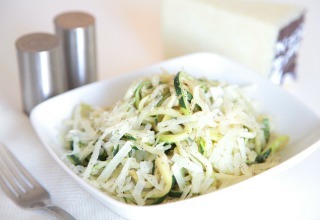 Cacio e Pepe means “cheese and pepper” and that’s all you need to make this gloriously simple pasta dish. Yes, pasta. If you have a favorite brand of gluten-free pasta, go for it. If not, “zoodles” work well for this dish, too. What matters most here is not the noodle, it’s the cacio e pepe.
Cacio e Pepe means “cheese and pepper” and that’s all you need to make this gloriously simple pasta dish. Yes, pasta. If you have a favorite brand of gluten-free pasta, go for it. If not, “zoodles” work well for this dish, too. What matters most here is not the noodle, it’s the cacio e pepe.
The type of cheese used for this classic Italian dish matters in a big way. It’s not just any cheese, it’s Pecorino Romano, an aged Italian cheese made from sheep’s milk. Don’t buy cheese labeled only “Romano,” and don’t buy it pre-grated. What you want is the real deal—a wedge of genuine Italian Pecorino Romano.
Once only made near Rome in the Lazio region of Italy, most Pecorino Romano is now made in Sardinia. Handmade in the ancient tradition, this great cheese is naturally rich in conjugated linoleic acid. In a 2010 trial, Pecorino Romano improved markers of inflammation and atherosclerosis in human subjects compared to a control cheese low in CLA.
A generous amount of grated Pecorino Romano finishes Cacio e Pepe after the (z)noodles are tossed in black pepper and bone broth. You’ll be amazed by how much flavor this dish has with so few ingredients. Easy to make, easy to love.
Servings: 2
Time in the Kitchen: 25 minutes
Ingredients

12-14 ounces (340 g to 400 g) zoodles (zucchini noodles) or 8 ounces (230 g) gluten-free pasta
2 tablespoons unsalted butter (30 g)
1 tablespoon extra virgin olive oil (15 ml)
2 teaspoons freshly cracked black pepper, or more to taste (10 ml)
1/4 cup bone broth (60 ml)
1 cup freshly grated Pecorino Romano cheese (90 g)
Instructions

If using zoodles, set aside for now. If using gluten-free pasta, then cook the pasta in boiling water and drain when it’s still al dente, about 2 minutes less than the regular cooking time. Set aside.
Sprinkle black pepper over a large skillet set on medium heat. Toast the pepper 20 seconds, then add the butter and olive oil. When the butter is completely melted, add bone broth to the skillet. Bring to a rapid simmer. Add the zoodles or pasta.
Cook about 2 minutes, tossing the noodles in the sauce, until zoodles or noodles are soft but not soggy.
Dump the noodles into a large bowl. Pour any leftover sauce in the skillet on top. Sprinkle in the cheese, tossing the noodles until the cheese is melted and noodles are coated. Add salt to taste. Serve immediately.


The post Cacio e Pepe appeared first on Mark's Daily Apple.



February 10, 2017
This Really Is a Family Story
It’s Friday, everyone! And that means another Primal Blueprint Real Life Story from a Mark’s Daily Apple reader. If you have your own success story and would like to share it with me and the Mark’s Daily Apple community please contact me here. In fact, I have a contest going right now. So if you have a story to share, no matter how big or how small, you’ll be in the running to win a big prize. Read more here.
 My journey to the primal life began in search of health, not weight loss. I could certainly lose a few pounds, but that is not what brought me here.
My journey to the primal life began in search of health, not weight loss. I could certainly lose a few pounds, but that is not what brought me here.
My work was very demanding; long hours, worked most holidays, high stress, constantly eating on the run, etc. I couldn’t sleep, had anxiety, had wacky hormones, and did not spend much quality time with my husband and two daughters. I started playing around with the paleo diet, and I devoured information on how to live a more healthy lifestyle. That is when I found you. I saw a functional medical doctor who diagnosed me with Hoshimoto’s and Adrenal Fatigue. That sealed the deal, and I was all in.
Luckily, my family has been completely supportive and is all in with me. It has been a fun adventure, and I love that The Primal Blueprint is not just about eating, but about lifestyle as well. Well meaning friends and family worry about my poor kids because they don’t get to eat the way other kids eat. Trust me, my kids are not suffering one bit. They truly love our meals and are developing quite mature palates. They did tell me I could not serve them liver ever again. I’ll give on that one. 
February 9, 2017
Humor for Health: What Modern Science and our Evolutionary Story Teach Us about Lightening Up
 I’ve always believed you could tell a lot about a person based on when they laugh. Or if they laugh at all. Laughter provides a brief but in-depth window into arguably the most enigmatic organ in the body—as well as the idiosyncrasies at work for that individual.
I’ve always believed you could tell a lot about a person based on when they laugh. Or if they laugh at all. Laughter provides a brief but in-depth window into arguably the most enigmatic organ in the body—as well as the idiosyncrasies at work for that individual.
I’ve suggested before that we adults take life way too seriously. Compared to the average child, who belts out around 400 laughs a day, we summon a measly 15-18 per day. Somehow I think we’re missing out with all that seriousness—mentally and maybe even physically.
Just think for a minute about how you feel when you DO laugh. (Can you remember the last time you did?) The almost involuntary force moving up the chest and out, the streaming eyes, shaking body, overall brightness, heady elation, the complete loss of anything even remotely resembling stress or worry. There you go.
Laughter is infectious, and there’s a reason for that. It heals the body, lifts the spirit, and elevates mood like nothing else can. It eases tension—for you and for a group. Emotionally, socially and physically, laughter’s benefits seem thoroughly underrated. The science seems to agree.
Grok as Funny Guy
Let’s back up a minute and look at the ancestral picture. Humor performed a critical function within evolution by encouraging social cohesion and alleviating the personal stress that could’ve otherwise kept Grok and his kin angry, desperate and inflexible in conditions that required a more adaptable response for survival.
Research shows that our ability to find amusement in dialogue and situations actually evolved in parallel with our neurological and physiological changes over millions of years. Researchers at Binghampton University postulate that laughter is a “preadaptation that was gradually elaborated and co-opted through both biological and cultural evolution.”
Humor in its early form probably developed in our distant hominid ancestors 2-4 million years ago. At this point, experts theorize that it was incorporated into those primal “societies” to promote resource-building and bond-forming social play during the brief periods of safety.
It makes sense. As our brains developed, our skill sets broadened, and more disposable chill time on our hands, a more complex social structure would have emerged. Humor and laughter were one of the binding agents that allowed tension between clan members to be alleviated, friendships to be formed, and (let’s be honest) sexual relationships to flourish.
With time, humor began to diversify into the varied forms we see today. Presumably, the way in which social humor forced Grok’s mind to compare and cross-reference imagined hilarity with real-world situations would have contributed to cognitive complexity. With an expanding brain, Grok and his line were more capable of creating and understanding complex humor, allowing more intricate and stronger social ties but also more innovative, creative thinking.
It’s interesting to look at the role of humor and the image of the humorless in existing hunter-gatherer societies. Take the Ju/‘hoan, a small population of hunter-gatherers in the southern part of Africa, for whom humor is used to encourage humility and cohesion: “humor is used to belittle the successful but boastful Ju/‘hoan hunter; if that fails, he will be shamed with the label !xka xan, ‘far-hearted’, meaning mean or stingy.” Man gets cocky, man gets a chance to not be so cocky courtesy of a few humorous wise cracks. If man doesn’t comply he gets called names. Fair—and usually enough in that setting to smooth things over and regroup.
While it can be said that we still share many behavioral and societal similarities with our ancestral cousins, it’s reasonable to say that humor was one of the things that set us apart during the early stages of our evolution. The frontal lobes of our brains make sense of the discrepancy between what we know to be true and the actual joke or comedic antics in question. This ability is unique to humans. While apes can “act up” and tease each other, they can’t actually shift back and forth between multiple interpretations of a scenario. This requires a comprehensive memory, which our brains were already in the process of developing over 4 millions years ago but went on to hone ever since.
With a larger brain, the depth and breadth of Grok’s memory database increased, enabling him to create and appreciate more subtle forms of humor. In this way, we see the evolution of humor in parallel with the evolution of the human species. Pretty darn cool, if you ask me.
Window into the Laughing Brain
Researchers at the University of Dartmouth sought to find out what parts of the brain fired up in response to humorous stimuli. They hooked study participants up to an fMRI machine to determine which areas of the brain activated during episodes of Seinfeld (great choice) and The Simpsons. Based on their responses, the team ascertained that joke detection occurred in the left side of the brain: specifically, the left inferior frontal and posterior temporal cortices.
This makes sense from what we already understand of these sections of the brain, with the left side helping us to process strange or curious information and cross-reference it with information already stored in our memory database. So, the jokes or on-screen shenanigans go in, are processed in relation to what we already know (a la memory bank), and emotional appreciation is created in the insular cortex and amygdala. Head-scratching jargon aside, that all seems relatively straightforward.
Scientists then looked at how different types of jokes were processed, finding that semantic jokes were processed in one area of the brain, puns in another, and cheesy “guy walks into a bar” type jokes processed in yet another location. Kind of makes you want to laugh at anything remotely funny when you imagine how hard your impoverished brain is working to process it!
Obviously, when we’re all over a punchline, our brains release a heady mix of dopamines via the amygdala. When we crack up, those dopamines are transmitted across the brain, which in turn helps us to join in, and possibly contribute to, the ensuing hilarity. When we’re depressed or anxious, however, our mesolimbic reward system switches off the dopamine valve, making it harder for us to find things funny when we’re in this state. The take-away? When you’re in a crummy mood, it’s difficult to open the humor valve, but once it’s cracked open, it’s hard to return to the doldrums.
Another study approached the use of MRIs and humor from a different angle. Researchers gathered up a crew of professional comedians, amateur comedians, and non-comedic volunteers, exposed them to certain amusing cues, and watched closely to see what parts of the brain lit up. In addition to verifying that specific regions in the left brain respond, they also discovered something interesting about the way comedians’ brains work.
Those professional comedians – and to a lesser extent the amateur comedians – had far more activity in the temporal lobe, which is associated with the generation of humor, than did the crackless non-comedic participants. In a curious tradeoff, however, they showed the least activity in the ventral striatum, the quintessential “pleasure center” and the location most associated with appreciation of humor.
It’s an intriguing bit of irony. In the process of becoming funnier, comedians increasingly lose the ability to appreciate humor generated by others. Maybe it’s a Faustian bargain, having simply immersed themselves in so much humor that those same dopamine receptors just don’t respond to the stimulus anymore. In any case, a bummer for them.
Professional comedians aside perhaps, the neurology of humor can tell us something about a person’s mental health. Neuropsychiatrist Richard Restak notes, “humor impairment may point to operational problems at various levels of brain functioning.” Restak goes on to explain that physical injuries to the right hemisphere of the brain, which plays an important role in enabling a “holistic” view of situations, can damage our ability to process and appreciate humor.
Damage to this part of the brain can prevent a person from shifting between pre-conceived assumptions (using that memory database I talked about earlier) and an ironic or silly alternative presented by a joke or cartoon. These patients would instead show a tendency towards being excessively literal, with an inability to make the comparisons between reality and make-believe that enables an appreciation of humor.
Humor’s Health Bonuses
And then there’s the other side of the coin—how our natural, human ability to appreciate and process humor confers physical benefit.
Not that this is a new insight. In the 14th century, French surgeon Henri de Mondeville recognized that humor was an important part of the healing process, actively encouraging friends and family to visit his patients in order to tell them jokes and cheer them up. The original Martin Luther, philosopher and catalyst in the 16th century Protestant Reformation, used humor in his mission to cure depressed followers. 18th century English physician William Battie used humor to treat illness.
You get the point. More recently, Norman Cousins described in his bestselling book, Anatomy of an Illness, how he attempted to treat a mysterious and rapidly progressive inflammatory illness (ankylosing spondylitis) of the spine by watching hour after hour of Marx Brothers films and reruns of Candid Camera (apparently that was actually funny in the 70s!).
While his claims were not, of course, scientifically verified, modern research suggests that any progress he made with his illness could indeed have been due to watching people, dogs, and other animate objects make fools of themselves. One study found that so-called “natural killer cells” were more active against cancer cells after people were shown a funny video. Curiously, those people who laughed out loud, as opposed to just smiling or smirking, had greater immune activity and increased killer cell activity.
Next, there’s the fact that laughter can provide a physical workout for the body. Research also demonstrates that laughter “can lead to immediate increases in heart rate, respiratory rate, respiratory depth and oxygen consumption.” Those effects are very similar to what we experience during moderate to intense exercise, burning off stored energy. Of course, it’s only around 50 calories per hour, but I’d venture to say it’s one of the more enjoyable ways to be “active.”
Finally, there’s the oft-repeated claim that humor, and particularly laughter, cuts through stress like a hot knife through butter. Sure, many of the studies that have sought to quantify the stress-alleviating effects of humor are contradictory, involved small control groups, and were driven by a bias in that the researchers started out to prove that laughter has benefits. All fair points. Admittedly, there’s a certain irony to the entire process as a whole. As E. B. White once noted, “humor can be dissected, as a frog can, but the thing dies in the process.”
But I don’t need science to prove beyond an exacting shadow of doubt this particular health claim for my purposes. I know it has substance, based on the fact that every time I laugh I feel good. My mood changes. The air clears. Those I’m with feel it, too, and we’re suddenly all the better for it. To me, these are easily the most important benefits of laughing. The physiological bonus is gravy, fascinating as it is.
Because ultimately I’m out for quality of life. Like good Primal eating, like play, like rest, humor offers the best of all worlds. It’s an essential hallmark of human identity. It’s a healing practice, a social unifier. It’s therapy, elixir and entertainment all at once.
In ancient ancestral community, these purposes inherently coexisted—for living social tradition and just holding one’s existence lightly. There’s a thought… We moderns miss the point of this grand venture when we limit our experience of finer states like curiosity, awe, euphoria—and most easily (and maybe especially) laughter.
So, go forth and find something to laugh at today. Netflix, YouTube, improv, memes, practical jokes in the office…whatever works for you. And share your thoughts (and favorite sources) in the comment section. Take care, everybody.

The post Humor for Health: What Modern Science and our Evolutionary Story Teach Us about Lightening Up appeared first on Mark's Daily Apple.



February 8, 2017
The Problem with Self-Improvement Culture (and What To Do About It)
 We’re a little more than a month out from New Year’s, and most people have abandoned their resolution efforts. Gyms are emptying out; the squat rack is free again. Cars are piling up in the drive-thrus, the farmer’s markets are noticeably emptier. Was it all for naught? Are the grand visions, the big plans, the lofty resolutions really going to culminate in a sad sputter…a fizzle? Will one-time optimists resign themselves to just another personal failing, another reason to slink back into despair? If January is about hope and ambition, what’s the lesson for February?
We’re a little more than a month out from New Year’s, and most people have abandoned their resolution efforts. Gyms are emptying out; the squat rack is free again. Cars are piling up in the drive-thrus, the farmer’s markets are noticeably emptier. Was it all for naught? Are the grand visions, the big plans, the lofty resolutions really going to culminate in a sad sputter…a fizzle? Will one-time optimists resign themselves to just another personal failing, another reason to slink back into despair? If January is about hope and ambition, what’s the lesson for February?
I’m not surprised. It happens every time, and it’s caused by our dysfunctional relationship to self-improvement.
Wait, what? Isn’t self-improvement a good thing?
Sure. Improving your health, happiness, life purpose, fitness, body composition, business, and/or relationships is undeniably a good thing. And there are dozens of reputable sources of information to help you make right changes—and make them stick. There’s a lot of good advice and inspiration out there.
In fact, there are now so many life coaches, dietary gurus, lifestyle designers, and other self-improvement professionals that you could probably sign up for a free introductory half-hour coaching session every single day for the rest of your life and never run out.
How many of us are actually heeding the advice from the experts and applying it to our own lives, though? If self-improvement seems like such an obvious virtue, why isn’t everyone doing it all the time?
It’s hard, for one. It often involves discomfort and requires that we relinquish our grip on convenience.
It means placing our immediate desires on hold for future rewards. It’s declining the cake today for the visible abs next month.
But there are also two other more pernicious impediments to our self-improvement that you might not be aware of. If we want to make any real changes, we have to address them.
Imagine you’re scrolling your Twitter feed, “liking” every inspirational quote that hits you just so, redirecting every book recommendation from trusted personalities into an Amazon wish-list you’ll never actually buy anything from, emailing yourself a particularly poignant TEDx talk that, at the time, you swear will change the way you look at the world.
Or maybe you’re listening to the latest episode of a guru’s podcast and the guest discusses her daily morning routine. You’re touched, you’re moved, you text a quick summary to a friend, and you resolve to adopt elements of it yourself. You jot down the gist, shove it into your “Things to Ponder” Evernote notebook, and promptly forget it ever existed.
Most people treat self-improvement like a spectator sport. They enjoy the feeling of being energized and excited about the prospect of real change and real improvements. When they’re reading the books, listening to the podcasts, scrolling through the Twitter feeds, watching the TED talks, consuming the content, they feel like they’re taking the first step toward self-improvement. It feels like a victory, and whenever we feel like we won or achieved something, we get a hit of dopamine. Dopamine perpetuates the action that initially triggered its secretion, which is why we can get addicted to dopaminergic drugs like caffeine, tobacco, and cocaine. But if we never take the second, third, fourth, or fiftieth steps, we never go anywhere real.
Consuming self-improvement content sure does feel productive. It tricks you into thinking you’ve just accomplished something. You have to keep going. Most don’t.
It’s totally normal to fail at self-improvements. Setbacks happen. And they’re not very fun, especially compared to that initial burst of inspiration when the dopamine is flowing and you’re imagining all the improvements you’ll make, all the work you’ll get done, all the productivity barriers you’ll hurdle. For a moment, you’re in the promised land. You’re doing things. That feels good. When it’s gone, replaced by the harsh reality that you failed to take the next step, it feels extra bad. That’s why self-help books are so popular, and new ones keep being published: when people read one and it doesn’t work, they move on to the next one. And there’s always a next one.
Which brings me to the second major problem: they react poorly to their initial failure. They give up. Instead of using the setback as motivation to never let it happen again, they just get down on themselves—”I’m a failure, and I’ll never be anything else,” For Grok’s sake, how about showing some compassion for yourself?
This is called self-compassion. It sounds fluffy. New-agey. But it works.
In one recent study, scientists found that coaching subjects to accept, confront, and show compassion to themselves for their failures increased subsequent willingness to improve their weaknesses. Compared to students practicing self-esteem, subjects who practiced self-compassion were more compelled to make amends after moral transgressions, spend more time studying for a hard test they’d already failed, and improve upon their weaknesses.
Another study found that practicing self-compassion led people to make healthier food choices.
Self-compassion mitigated the stultifying effects of regret.
Self-compassion promoted more self-improvement. Self-esteem promoted less.
This makes perfect sense. You accept your mistakes and move forward, because where else can you go? Self-esteem meanwhile feels artificial and forced, probably because it is. Esteem should emerge from estimable acts and successes, not be tacked on to failures.
According to the researcher who discovered the power of self-compassion, we’re really dealing with three main points:
Self-kindness: Being as nice and understanding to yourself as you would to someone else.
Common humanity: We’re all in this together, and everyone else either is hurting or has been hurt. You’re not alone.
Mindfulness: Observing reality without judgement.
In other words, talk to yourself the way you’d talk to any friend, loved one, or child who was also hurting. What would you say—literally? Say it to yourself, too.
Self-compassion isn’t about lulling us into stagnancy. It allows us to continually come at life—and our goals—from a place of intactness. Why give energy to a denigrating voice? It only divides you against yourself—a waste if you ask me. Self-compassion reintegrates us. We’re stronger, more solid, and more patient as a result.
Then we’re able to bring real resilience to our self-development aims. We’re not dependent on the string of motivational fixes from outside sources. We’re not moved to abandon an effort when we lose our footing. We accept the process insomuch as we accept ourselves in it. And that’s the real starting point for success.
Thanks for reading, everybody. Share your thoughts, and have a great day.

The post The Problem with Self-Improvement Culture (and What To Do About It) appeared first on Mark's Daily Apple.



February 7, 2017
20 Easy Bodyweight Exercises To Build Functional Arm Strength
 Today’s post is from Jennifer Dene at Paleohacks.
Today’s post is from Jennifer Dene at Paleohacks.
Ready to develop your upper body? Skip the isolation exercises and build functional arm strength with these 20 easy bodyweight exercises — no gym membership required!
Functional training exercises mimic moves that we do in real life. These exercises often include compound movements that integrate multiple muscle groups at once. The benefit of functional training is increased strength, agility, mobility, and reduced risk of injury.
When it comes to increasing arm strength, many workout routines isolate the “vanity muscles” — biceps and deltoids in particular get a lot of love and attention. Unfortunately, these isolation exercises can cause an imbalance in muscle development, which puts the arms and shoulders at increased risk of strain or injury.
The key to well-developed arms (that are as practical as they are pretty) is to focus on functional, compound movements. Each arm workout should include a combination of mobility, stability, and strength exercises, targeting each of the muscles through the upper and lower arms, and the front, back and sides of the shoulders.
This workout starts with mobility and stability exercises that are suitable for all levels. It then moves on to a series of basic bodyweight arm exercises; your current level of strength will determine how challenging you find these moves. The final “power set” is best suited to individuals with advanced fitness. Feel free to skip any of the exercises in this section until you are ready for the challenge.
The moves in each section prepare you for what will come next. For example, the inchworm prepares your body for a push-up, which prepares your body for a power push-up. Start at the top and work your way through.
Mobility & Stability
Arm Swings: Dynamic stretching warms up the muscles you will be using during your workout. Stand with your back straight and abs engaged, gently start swinging your arms out to the side and then crossing them in front of your body, alternating which arm swings in front. Gradually start making the swings larger so you can feel a slight stretch in your chest and between your shoulder blades. Swing arms 20-30 times.

Wall Clocks: Wall clocks are a great exercise for shoulder stability as they recruit your rotator cuff and scapular stabilizers. Place your hands on a wall about shoulder-width apart. Without shrugging your shoulders up, slide one hand out to the side, still touching the wall. Move the hand back to the starting position. Perform 3 sets of 5 on each side.

Scapula Retraction (Shoulder Blades Squeeze): This exercise will strengthen the middle back muscles, which keep your shoulders healthy. Stand with your shoulders relaxed and arms down by the side. Gently retract your shoulder blades by pretending you are trying to squeeze a tennis ball in the middle of your back. Release the shoulders back to the starting position. Keep your upper shoulders relaxed throughout the exercise. Perform 3 sets of 10.

Extend & Flex: Training the forearms, wrists and hands in all planes of motion will help you improve your grip for weighted arm exercises, as well as reduce elbow and wrist strain. Start with your arms extended away from your chest, palms facing down, and fingertips reaching long. Bend the wrist and point the fingertips down towards the ground. Flex the wrist and point the fingertips up towards the ceiling. Keep a slight bend in the elbows and keep the upper arm still as you move the wrists. This exercise strengthens and stretches the forearm flexors. Perform 12 to 16 repetitions in each direction.
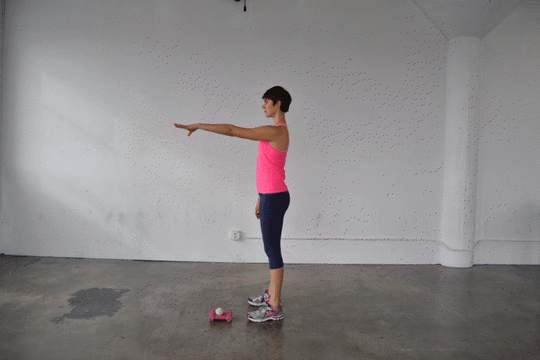
Inchworm: This exercise prepares your body for push-ups, which will strengthen the chest, arms, shoulders, and core. Start by standing at the end of your mat with your feet hip-distance apart. Bend forward to place your hands flat on the mat in a forward fold (your knees may bend slightly). Walk your hands out about a foot at a time all the way out into a full plank position. Hold in the plank for a second or two, walk your hands all the way back into the forward fold, and roll up to standing. Repeat 5 times.
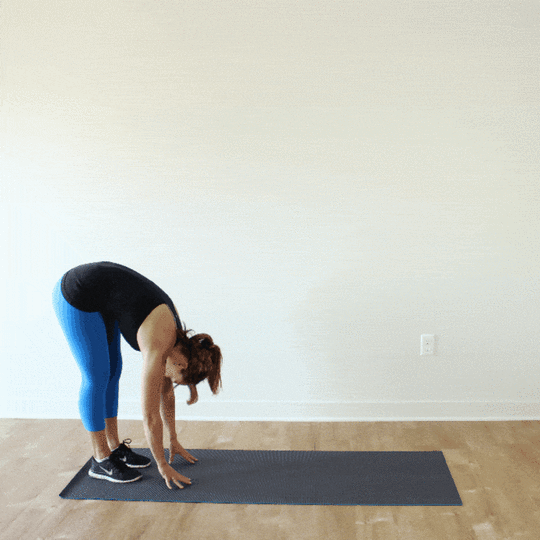
Chest Foam Roller Stretch: When your chest muscles get tight, it pulls your shoulders into a forward rounded position. This weakens the back of the shoulders and compromises your ability to perform planks and push-ups. Lie down along the center of a foam roller or rolled up blanket. Press your low back flat against the roller. Open your arms to the side at a 45-degree angle and let gravity bring your arms down towards the floor. Stay in this position and breathe for 1 – 2 minutes.

Upward Facing Dog: This move wakes up the back of the shoulders, and the triceps at the back of the upper arm. Keep your elbows tucked in towards your torso. Lay on your stomach and place your hands under your shoulders, with your palms flat on the floor. Draw your chest forward, press down through the tops of the feet and straighten your arms to come to Upward-Facing Dog. The legs are strong and active, the shoulders are relaxed down away from the ears, and your focus is on extending through your upper back, not stressing your lower back. Hold for 3 seconds before lowering. Repeat 3 – 5 times.

Basics
Mastering basic functional arm exercises is an absolute must before moving on to the more complex, and power-based, moves. The following exercises strengthen the arms and shoulders, as well as the core. If you are advanced enough to complete the entire workout, including the “power” section, the basics act as the second phase of your warm up.
Wide Pushup: Having a wide hand position will allow you to focus on your chest muscles and front shoulder muscles. Start in a full plank position, with your hands slightly wider than your shoulders and in line with your chest. Engage your abs, and lower into a push-up. At the bottom of the push-up your elbows should bend to the side at a 90º angle. Press back up to the starting position. Repeat 5 – 10.

Narrow Pushup: This variation focuses on the tricep muscle, which is smaller and weaker than the chest, making it a bit harder than the wide push-up. Start in a full plank position with your hands directly under your shoulders. Engage your abs and lower into a push-up. At the bottom of the push-up your elbows should be close to your sides, with the elbow joint pointing back. Press back up to the starting position. Repeat 5 – 10.

Lateral Plank Walk: This exercise strengthens the lateral delts; these muscles help you lift objects straight out to the side of your body. Start in a full plank position with your hands directly under your shoulders and feet hip-distance apart. Slightly shift your weight into your left hand and leg as you step your RIGHT hand and foot out about six inches to the right. Slightly shift over to the right side of your body as you step the LEFT hand and foot to come back underneath you. Continue stepping your hands and feet over to the right for 5-10 “steps” before stepping back to the LEFT. Repeat 3 rounds.
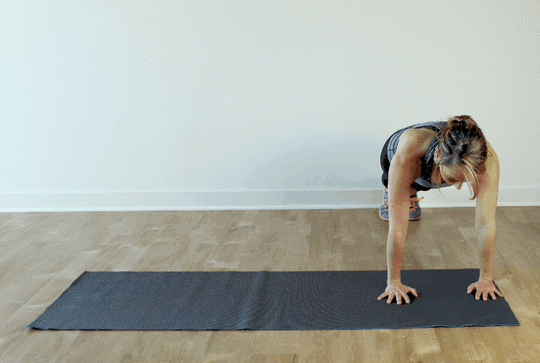
Forearm Side Plank: This targets the shoulder stabilizers, triceps, and obliques…all muscles that can get ignored during every day life! Lay on your RIGHT side, stacking your hips and feet. Position your bottom RIGHT elbow directly under your RIGHT shoulder. Lift your bottom hip off the ground to create a straight line in a plank. Your should be lifting from your bottom oblique and feel a slight pinch in the waistline. Reach your top hand towards the ceiling or place it on your top hip. Hold for 10 – 30 seconds. Switch sides. (To modify this exercise, keep your bottom knee on the ground.)

Rear Deltoid Raise: This exercise can be done with or without free-weights. Stand with your feet shoulder-width apart, holding your dumbbells with palms facing in. Hinge from your hips and lower your torso down towards the floor so that it is almost parallel to the floor. With a very slight bend in the elbows, squeeze your shoulder blades together as you raise your arms out to the sides. Slowly and with control, lower the weights back down. Be sure to relax your traps and neck as much as possible. Repeat 3 sets of 10 repetitions.
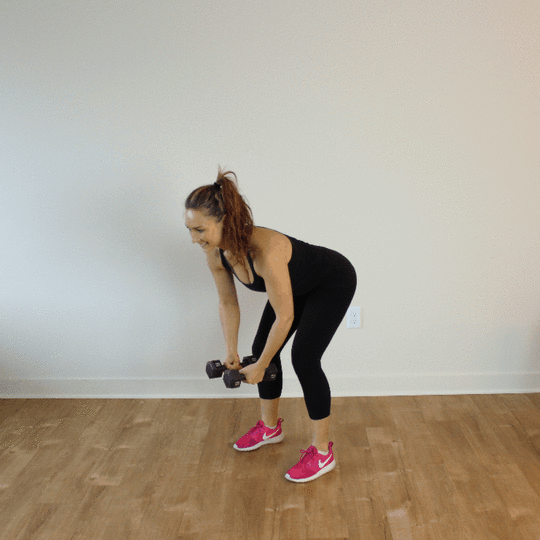
Tricep Dips: Use a kitchen chair, coffee table, park bench, or even the side of your bed for this exercise. Sit on a chair or table and place your hands on the edge so that your fingers are hanging off. Keep the shoulders over the wrists as you lift your hips up and place them just in front of the chair. Bend your elbows and lower your hips down, making sure to keep your elbows pressing back and your chest lifted. Press back up using the backs of your arms. Repeat 3 sets of 10 repetitions.
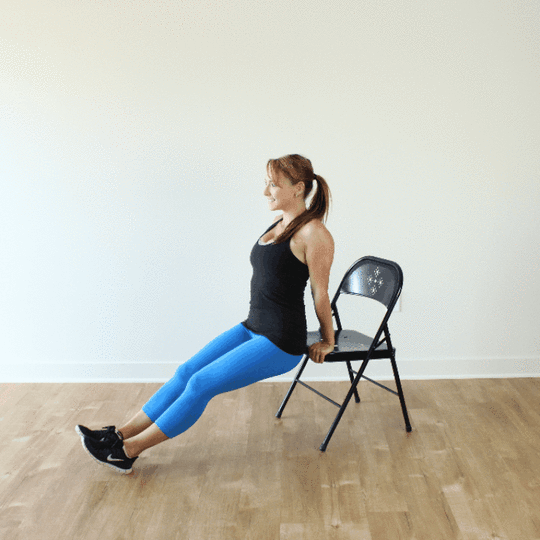
Reverse Plank: This targets the triceps, rear deltoids, and stretches the chest. Start seated with bent knees, feet flat on the floor, and the arms extended behind you with fingertips pointing towards your feet. Keep a slight bend in the elbow, squeeze your backside and then lift the hips straight up, so that you’re in a flat line from throat to knees. The head can look up to the ceiling or down along the thighs. Continue to squeeze the legs and lengthen the spine as you hold for 5 breaths. To advance, straighten the legs. Repeat 3 rounds.
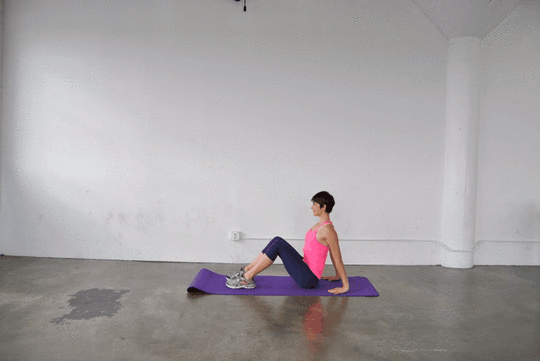
Decline Pushup: This is a progression for regular wide or narrow push-ups. It increases the resistance, and focuses on the upper part of your chest and the shoulders. The higher your feet are elevated the more challenging the exercise will become. Place your hands on the floor, wrists a little wider than shoulders*, and carefully step your feet back onto a (stable) chair or bench. You should now be in plank position. Perform a push-up, bending the elbows to the side, and keeping your spine completely flat. Start with a smaller decline and work your way to a higher level, once you’re ready. *You can use the wide or narrow push-up hand position. Repeat 3 sets of 5 – 10.

Pike Pushups: This push-up targets the top of the shoulders, similar to an overhead press, and prepares your body for handstands! Start in a downward-facing dog position, with the hands wider than the shoulders. Shift more weight into your hands than your feet, and look at your belly button to keep your neck in line with your spine. Bend the elbows out to the side and lower until the crown of your head just hovers above the ground; press back up. Repeat 3 sets of 5 – 10.

Dead Hangs: This exercise strengthens your grip (hands and forearms), and prepares your body for the pull-up. Find a horizontal bar, which you can easily jump up to and reach. Jump up and hold onto the bar, with the palms facing away from you. Now hang there, but here’s the key—maintain tension in your upper body, back, and core. It’s easy to dangle from a pull-up bar, but during a dead hang your shoulders should be down and your core tight. This helps activate the muscles you’ll need for pull-up power. Hold for 10 – 30 seconds.

Power Set
These final four exercises are definitely advanced. They use multiple muscles, require great core strength and postural alignment, and may or may not be right for you today. If you’re not quite there yet, keep at it and use these exercises as a goal.
Push Offs: This exercise adds an explosive element to the push-up, which engages more muscle fibers throughout the entire arm, shoulders and core. Start in a plank position with your hands directly under your shoulders. Bend the elbows to lower down towards the floor, keeping your elbows close by your sides, as if you were doing a narrow push-up. As you press back up, power through your arms and push the hands an inch or two off the ground. Land softly, immediately bending the elbows back into another push-up. Repeat for 10-20 repetitions, and modify by doing this raised on a bench or chair if needed.
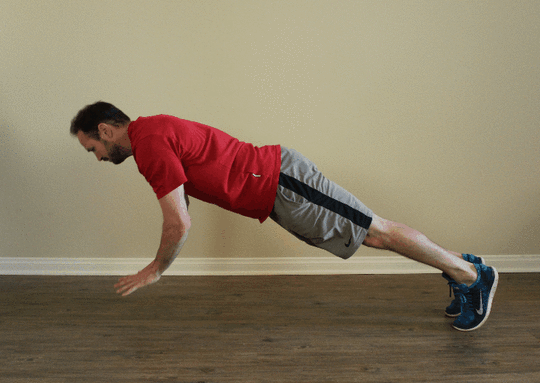
Wide to Narrow Pushup: To take the previous exercise even further try switching between a wide and narrow push-up, after each hand “jump.” Begin by performing a narrow-style push off, as written above. However, once you have powered off the floor, quickly separate your hands further apart, to land in a wide push-up position (elbows bent to land). Push off again and land in the narrow position (elbows bent to land). That’s one full repetition. Complete 4 – 8 full repetitions.

Pull Ups: This is a fantastic exercise for functional upper body strength. Depending on your grip, you can target biceps, triceps, lats, traps, shoulders, and core. Find a horizontal bar, which you can easily jump up and reach. Pictured is a traditional neutral-grip position, but you can also do wide or narrow variations (wide grip, palms face away from you, narrow grip, palms face towards you). Jump up and hold onto the bar. Then draw your shoulder blades down your back and away from your ears. Use your biceps, and squeeze your shoulder blades together as you draw your chest up towards the bar—holding at the top for a second. With control, lower back down and repeat for 10-20 repetitions.

There you go: 20 moves for your workout today. Let me know which ones will make it into your routine this week. A big thanks to Paleohacks for the fantastic list! Have a great day, everybody.

The post 20 Easy Bodyweight Exercises To Build Functional Arm Strength appeared first on Mark's Daily Apple.



Mark Sisson's Blog
- Mark Sisson's profile
- 199 followers



